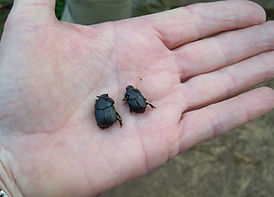DUNG BEETLE SPECIES

Bubas bubalus
Bubas bubalus
(Length 13-22mm)
Identifying features
Bubas bubalus is similar in appearance to Bubas bison – it is medium to large shiny black beetle (13 – 22mm). Large males (major males) have a large curved horn on each side of the head and a slight indented projection at the front of the pronotum. Smaller (minor) males also have a horn on each side of the head and a reduced projection on the pronotum. Females have a distinct ridge and a small tubercle (small bump) on the head, between the eyes. The pronotum has a curved ridge at the front which is separated in the middle.
Distribution
Bubas bubalus is a native of southern Europe. Previous attempts to establish Bubas bubalus were unsuccessful however, their predicted ability to effectively control manure in early spring is driving the current reintroduction effort.
In the spring of 2014, Bubas bubalus was released at six locations across southern Australia (in WA, SA and NSW) where the climate is predicted to be optimal for establishment. The sites will be monitored over the coming years to track the establishment and success of these new dung beetle species in Australia.
Additional Information
Bubas bubalus is a typical nocturnal species with daily flight activity restricted to the last hours of daylight when light intensity is low (Lumbreras et al. 1999). It occurs in grassy pastures, but it is also found in open woodland. It colonises fresh dung and is one of the main species responsible for the degradation of cattle dung. It has also been cited as having necrophagous habits (Veiga 1982).
The species has no clear preference for particular types of dung, although it needs large quantities of this resource when egg-lying. This could mean it could be more abundant in sites with cattle and horse dung (J.P. Lumaret pers. comm. 2014).
Emergence and oviposition vary in the different countries of occurrence, depending on the temperature. In Spain, the adults are found in the manure generally between October and June, with two peaks of abundance in May and October (Lumbreras et al. 1999, Mena Bayo 1999). In France the emergence of adults starts in March with a peak in June (oviposition); larval development in summer with few emergences of adults in October (Paulian and Lumaret 1972, Lumaret 1990).
